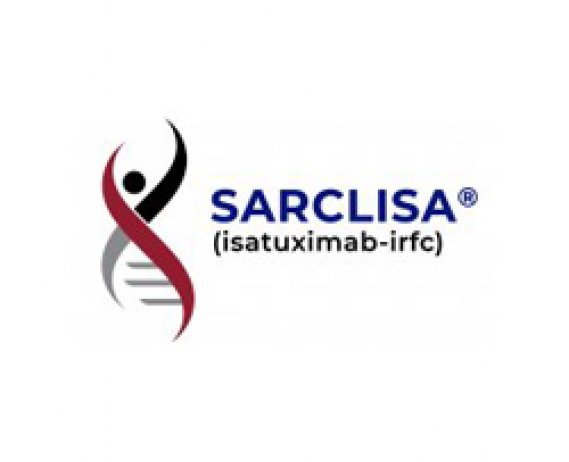What Is Sarclisa?
Sarclisa® is a monoclonal antibody directed against the CD38 receptor on the surface of myeloma cells. This targeted anti-myeloma therapy kills myeloma cells directly. It also recruits surrounding immune cells to enhance this killing process.
How Does Sarclisa Work?
Sarclisa works in three distinct ways to reduce the number of myeloma cells in your body:
- It finds and binds to myeloma cells and exposes them for elimination by your immune system.
- It helps boost your immune system, making it harder for myeloma cells to survive.
- It directly kills myeloma cells.
Who is a Candidate for Sarclisa?
The Food and Drug Administration (FDA) has approved Sarclisa for adult patients with myeloma as follows:
- In combination with the immunomodulatory agent Pomalyst® (pomalidomide) and the steroid dexamethasone(Isa-Pd) for patients who have received at least 2 prior therapies including the immunomodulatory agent Revlimid® (lenalidomide) and proteasome inhibitor, such as Velcade® (bortezomib), Ninlaro®(ixazomib), or Kyprolis® (carfilzomib).
- In combination with Kyprolis (carfilzomib) and dexamethasone (Isa-Kd) for patients with relapsed or refractory myeloma who have received 1 to 3 prior lines of therapy.
How Is Sarclisa Administered?
Sarclisa is administered by intravenous (IV, or through the vein) infusion.
What Are the Dose and Schedule of Sarclisa Regimens?
Two different combinations are approved for administering Sarclisa.
1. Sarclisa (isatuximab-irfc), pomalidomide, and dexamethasone combination therapy, or Isa-Pd
In this combination, Sarclisa is given as an intravenous (IV) infusion at a dose of 10 mg/kg once-weekly for the first 4 weeks, then once every other week.
- The first infusion takes about 3–4 hours.
- The second infusion is about 2 hours.
- The subsequent infusions are typically 75 minutes
In addition,
- Pomalyst is taken by mouth in capsule form at a dose of 4 mg on days 1–21 of every 28-day cycle.
- Dexamethasone can be taken by mouth or as an IV infusion at a dose of 40 mg once-weekly, or at 20 mg once-weekly for patients over 75 years of age.
2. Sarclisa (isatuximab-irfc), Kyprolis, and dexamethasone combination therapy, or Isa-Kd
In this combination, Sarclisa is given as an IV infusion at a dose of 10 mg/kg once-weekly for the first 4 weeks, then once every other week.
- The first infusion takes about 3–4 hour.
- The second infusion is about 2 hours.
- The subsequent infusions are typically 75 minutes.
In addition,
- Kyprolis is administered as a once-weekly IV infusion at a dose of 20 mg/m2 in the first cycle.
- During subsquent cycles, Kyprolis is administered once every other week at 56 mg/m2.
- Dexamethasone is administered on days 1, 2, 8, 9, 15, 16, 22, and 23 of each 28-day cycle at a dose of 20 mg. It is given as an IV infusion on days of Sarclisa and/or Kyprolis and taken orally by tablet on other days.
What Are Possible Side Effects of Sarclisa?
For Isa-Pd:
The most common side effects occurring in ≥ 20% of patients include
- upper respiratory tract infection
- infusion-related reactions
- diarrhea
- pneumonia
The most common hematology laboratory abnormalities (≥ 80%) were decreased levels of hemoglobin, neutrophils, lymphocytes, and platelets.
Possible serious side effects include pneumonia (26%), upper respiratory tract infections (7%), and febrile neutropenia (7%). Reported fatal adverse reactions that occurred in more than 1% of patients were pneumonia and other infections (3%).
For Isa-Kd:
The most common side effects occurring in ≥ 20% of patients include
- upper respiratory tract infection
- infusion-related reactions
- fatigue
- hypertension
- diarrhea
- pneumonia
- shortness of breath
- insomnia
- bronchitis
- cough
- back pain
The most common hematology laboratory abnormalities were decreased levels of hemoglobin, lymphocytes, and platelets.
Possible serious side effects include pneumonia (25%) and upper respiratory tract infections (9%). Reported fatal adverse reactions that occurred in more than 1% of patients during treatment were pneumonia (1.7%) and cardiac failure (1.1%).
Access to Sarclisa and Other Resources
CareASSIST by Sanofi Genzyme helps eligible patients with access and support for Sarclisa. To explore the services and resources that may be available for you, please call 1.833.930.2273 or visit https://www.sanoficareassist.com/sarclisa/.
The International Myeloma Foundation medical and editorial content team
Comprised of leading medical researchers, hematologists, oncologists, oncology-certified nurses, medical editors, and medical journalists, our team has extensive knowledge of the multiple myeloma treatment and care landscape. Additionally, Dr. Brian G.M. Durie reviews and approves all medical content on this website.
Last Medical Content Review: September 24, 2021







